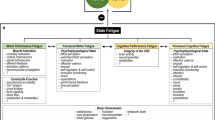Summary
Recovery processes have been studied in severe work of uniform intensity continuing from a minimum of 5 seconds to a maximum of 106 seconds. The work was largely anaerobic, requiring the accumulation of an oxygen debt, the magnitude of which was approximately a linear function of time.
The rate of removal of lactic acid is a logarithmic function of time; the rate varies somewhat from time to time and from one person to another. In the type of activity studied the lactic acid accumulated is proportional to the duration of work. The total oxygen debt as well as the lactacid debt being proportional to duration of work, it follows that the so-called alactacid debt is also proportional to the duration of work. In other words, the lactacid debt and the alactacid debt in such activity are contracted concurrently.
The oxygen intake in recovery may be analyzed into a rapid process nearly complete in 5 minutes which pays the alactacid debt, a process about 1/20th as rapid which pays the lactacid debt, and finally an increase in resting metabolism which decreases in a linear fashion until the pre-exercise level is reached. The excess R. Q for the entire process of work and recovery probably lies within the range 0,9 to 1,0.
Similar content being viewed by others
Bibliography
Margaria, R., H. T. Edwards andD. B. Dill: Amer. J. Physiol.106, 689 (1933).
Benedict, F. G. andE. F. Cathcart: Carnegie Inst. Washington, Publication 1913, Nr 187.
Lundsgaard, E.: Biochem. Z.217, 162 (1931).
Clark, A. J., M. C. Eggleton andP. Eggleton: J. of Physiol.25, 332 (1932).
Margaria, R. andH. T. Edwards: Amer. J. Physiol.107, 681 (1934).
Margaria, R. andH. T. Edwards: Amer. J. Physiol.108, 341 (1934).
Benedict, F. G.: J. of biol. Chem.20, 263 (1915).
Simonson andSirkina: Arb.physiol.8, 560 (1935).
Herxheimer, H.: Arb.physiol.8, 801 (1935).
Hill, A. V., C. N. H. Long andH. Lupton: P. I-III, Proc. roy. Soc. Lond. s. B,96; P. IV–VI, s. B.97; P. VII bis VIII, s. B.97 (1924).
Solandt, O. M. andJ. H. Rideout: Proc. roy. Soc. Lond.133, 327 (1933).
Sargent, R. M.: Proc. roy. Soc. Lond. s. B.,100, 440 (1926).
Best, Furusawa andRideout: Proc. roy. Soc. Lond. s. B.,104, 119 (1929).
Dill, D. B., H. T. Edwards andR. H. de Meio: Amer. J. Physiol.111, 9 (1935).
Christensen, E. H., A. Krogh andJ. Lindhard: Quart. Bull. Health Org.3, Nr 15.
Irving, L. H., C. Foster andJ. K. W. Ferguson: J. of biol. Chem.95, 95 (1932).
Gemmill, C., W. Booth, J. Detrick andH. Schiebel: Amer. J. Physiol.96, 265 (1931).
Cathcart, E. P. andJ. Markowitz: J. of Physiol.63, 309 (1927).
Krogh, A. andJ. Lindhard: Biochem. J.14, 290 (1920).
Rapport, David: Physiol. Rev.10, 349 (1930).
Author information
Authors and Affiliations
Rights and permissions
About this article
Cite this article
Dill, D.B., Edwards, H.T., Newman, E.V. et al. Analysis of recovery from anaerobic work. Arbeitsphysiologie 9, 299–307 (1936). https://doi.org/10.1007/BF02011084
Received:
Issue Date:
DOI: https://doi.org/10.1007/BF02011084




